Strategic Analysis and Recommendations for Virgin Airlines
VerifiedAdded on 2020/05/28
|9
|1919
|36
Report
AI Summary
This report provides a strategic analysis of Virgin Airlines, examining its current strategies, market position, and challenges within the airline industry. It begins with an introduction to Virgin Airlines, its history, and its market presence, followed by an overview of its current strategies and performance. A PEST analysis is conducted to assess the external factors influencing the airline's operations. The report highlights the impact of Richard Branson's departure and the limitations of the airline's market reach. Recommendations are then proposed, focusing on expanding markets, implementing effective marketing strategies, and refining brand positioning. The report concludes with a summary of the key findings and recommendations, emphasizing the need for Virgin Airlines to adapt and innovate to maintain its competitiveness in the dynamic airline industry. References are included for further reading.
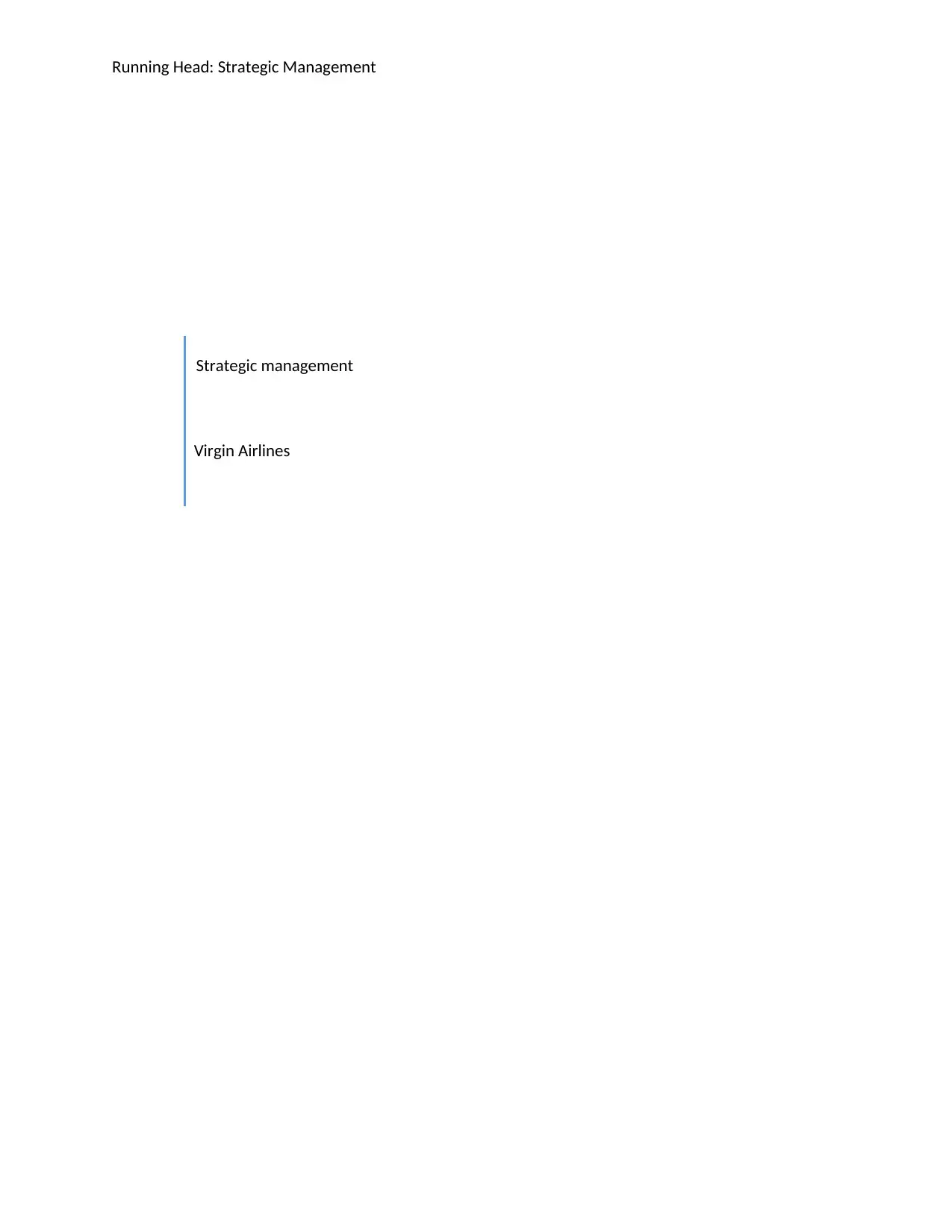
Running Head: Strategic Management
Strategic management
Virgin Airlines
Strategic management
Virgin Airlines
Paraphrase This Document
Need a fresh take? Get an instant paraphrase of this document with our AI Paraphraser
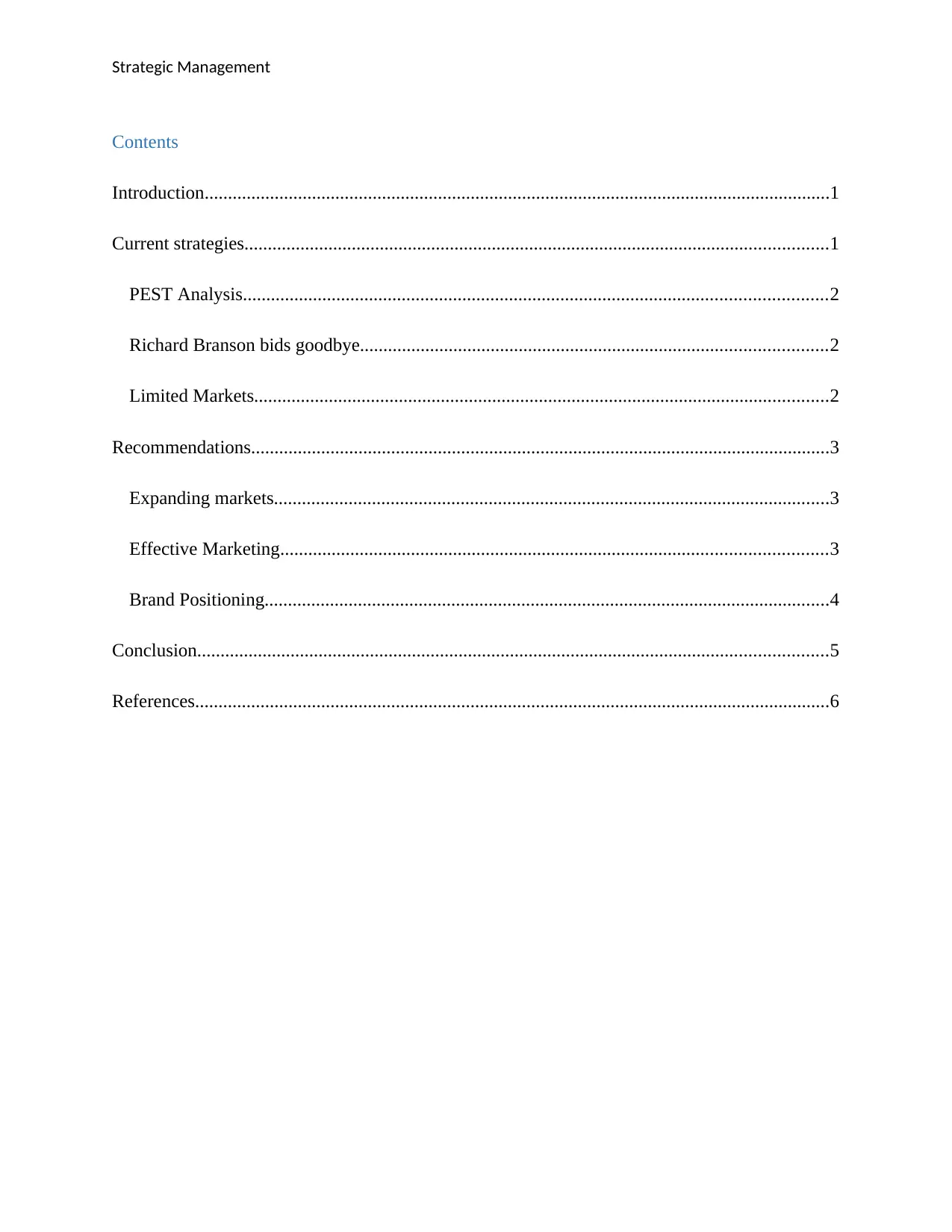
Strategic Management
Contents
Introduction......................................................................................................................................1
Current strategies.............................................................................................................................1
PEST Analysis.............................................................................................................................2
Richard Branson bids goodbye....................................................................................................2
Limited Markets...........................................................................................................................2
Recommendations............................................................................................................................3
Expanding markets.......................................................................................................................3
Effective Marketing.....................................................................................................................3
Brand Positioning.........................................................................................................................4
Conclusion.......................................................................................................................................5
References........................................................................................................................................6
Contents
Introduction......................................................................................................................................1
Current strategies.............................................................................................................................1
PEST Analysis.............................................................................................................................2
Richard Branson bids goodbye....................................................................................................2
Limited Markets...........................................................................................................................2
Recommendations............................................................................................................................3
Expanding markets.......................................................................................................................3
Effective Marketing.....................................................................................................................3
Brand Positioning.........................................................................................................................4
Conclusion.......................................................................................................................................5
References........................................................................................................................................6
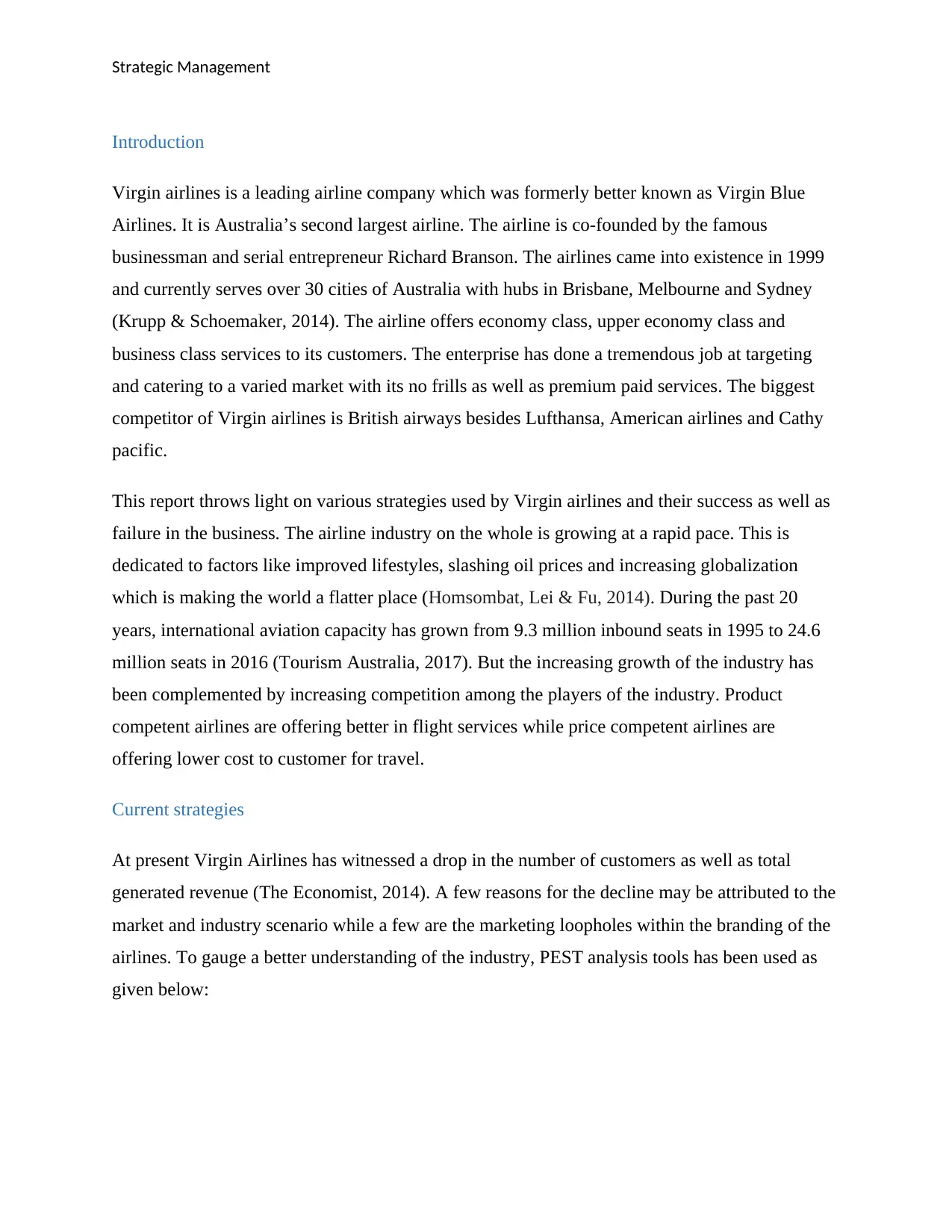
Strategic Management
Introduction
Virgin airlines is a leading airline company which was formerly better known as Virgin Blue
Airlines. It is Australia’s second largest airline. The airline is co-founded by the famous
businessman and serial entrepreneur Richard Branson. The airlines came into existence in 1999
and currently serves over 30 cities of Australia with hubs in Brisbane, Melbourne and Sydney
(Krupp & Schoemaker, 2014). The airline offers economy class, upper economy class and
business class services to its customers. The enterprise has done a tremendous job at targeting
and catering to a varied market with its no frills as well as premium paid services. The biggest
competitor of Virgin airlines is British airways besides Lufthansa, American airlines and Cathy
pacific.
This report throws light on various strategies used by Virgin airlines and their success as well as
failure in the business. The airline industry on the whole is growing at a rapid pace. This is
dedicated to factors like improved lifestyles, slashing oil prices and increasing globalization
which is making the world a flatter place (Homsombat, Lei & Fu, 2014). During the past 20
years, international aviation capacity has grown from 9.3 million inbound seats in 1995 to 24.6
million seats in 2016 (Tourism Australia, 2017). But the increasing growth of the industry has
been complemented by increasing competition among the players of the industry. Product
competent airlines are offering better in flight services while price competent airlines are
offering lower cost to customer for travel.
Current strategies
At present Virgin Airlines has witnessed a drop in the number of customers as well as total
generated revenue (The Economist, 2014). A few reasons for the decline may be attributed to the
market and industry scenario while a few are the marketing loopholes within the branding of the
airlines. To gauge a better understanding of the industry, PEST analysis tools has been used as
given below:
Introduction
Virgin airlines is a leading airline company which was formerly better known as Virgin Blue
Airlines. It is Australia’s second largest airline. The airline is co-founded by the famous
businessman and serial entrepreneur Richard Branson. The airlines came into existence in 1999
and currently serves over 30 cities of Australia with hubs in Brisbane, Melbourne and Sydney
(Krupp & Schoemaker, 2014). The airline offers economy class, upper economy class and
business class services to its customers. The enterprise has done a tremendous job at targeting
and catering to a varied market with its no frills as well as premium paid services. The biggest
competitor of Virgin airlines is British airways besides Lufthansa, American airlines and Cathy
pacific.
This report throws light on various strategies used by Virgin airlines and their success as well as
failure in the business. The airline industry on the whole is growing at a rapid pace. This is
dedicated to factors like improved lifestyles, slashing oil prices and increasing globalization
which is making the world a flatter place (Homsombat, Lei & Fu, 2014). During the past 20
years, international aviation capacity has grown from 9.3 million inbound seats in 1995 to 24.6
million seats in 2016 (Tourism Australia, 2017). But the increasing growth of the industry has
been complemented by increasing competition among the players of the industry. Product
competent airlines are offering better in flight services while price competent airlines are
offering lower cost to customer for travel.
Current strategies
At present Virgin Airlines has witnessed a drop in the number of customers as well as total
generated revenue (The Economist, 2014). A few reasons for the decline may be attributed to the
market and industry scenario while a few are the marketing loopholes within the branding of the
airlines. To gauge a better understanding of the industry, PEST analysis tools has been used as
given below:
⊘ This is a preview!⊘
Do you want full access?
Subscribe today to unlock all pages.

Trusted by 1+ million students worldwide
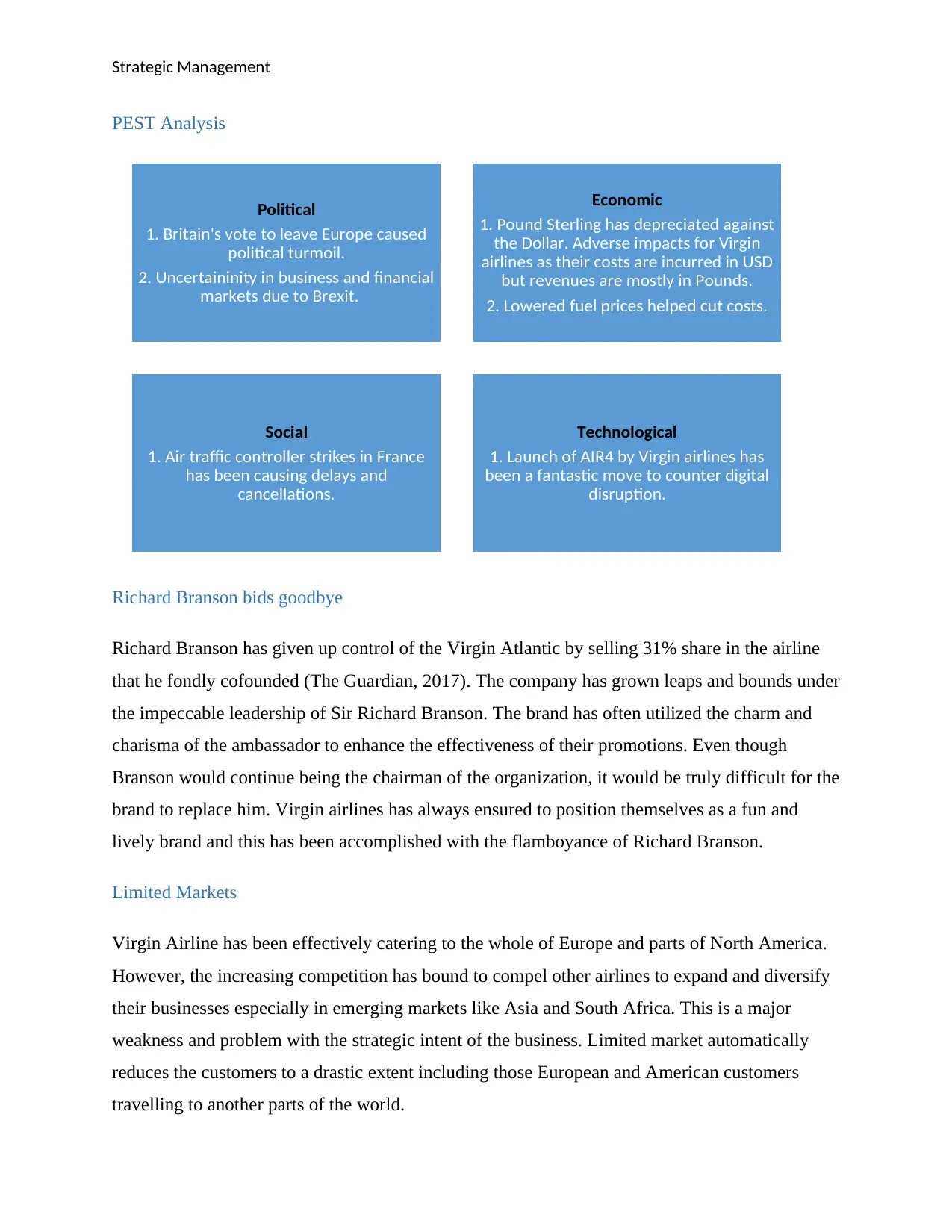
Strategic Management
PEST Analysis
Richard Branson bids goodbye
Richard Branson has given up control of the Virgin Atlantic by selling 31% share in the airline
that he fondly cofounded (The Guardian, 2017). The company has grown leaps and bounds under
the impeccable leadership of Sir Richard Branson. The brand has often utilized the charm and
charisma of the ambassador to enhance the effectiveness of their promotions. Even though
Branson would continue being the chairman of the organization, it would be truly difficult for the
brand to replace him. Virgin airlines has always ensured to position themselves as a fun and
lively brand and this has been accomplished with the flamboyance of Richard Branson.
Limited Markets
Virgin Airline has been effectively catering to the whole of Europe and parts of North America.
However, the increasing competition has bound to compel other airlines to expand and diversify
their businesses especially in emerging markets like Asia and South Africa. This is a major
weakness and problem with the strategic intent of the business. Limited market automatically
reduces the customers to a drastic extent including those European and American customers
travelling to another parts of the world.
Political
1. Britain's vote to leave Europe caused
political turmoil.
2. Uncertaininity in business and financial
markets due to Brexit.
Economic
1. Pound Sterling has depreciated against
the Dollar. Adverse impacts for Virgin
airlines as their costs are incurred in USD
but revenues are mostly in Pounds.
2. Lowered fuel prices helped cut costs.
Social
1. Air traffic controller strikes in France
has been causing delays and
cancellations.
Technological
1. Launch of AIR4 by Virgin airlines has
been a fantastic move to counter digital
disruption.
PEST Analysis
Richard Branson bids goodbye
Richard Branson has given up control of the Virgin Atlantic by selling 31% share in the airline
that he fondly cofounded (The Guardian, 2017). The company has grown leaps and bounds under
the impeccable leadership of Sir Richard Branson. The brand has often utilized the charm and
charisma of the ambassador to enhance the effectiveness of their promotions. Even though
Branson would continue being the chairman of the organization, it would be truly difficult for the
brand to replace him. Virgin airlines has always ensured to position themselves as a fun and
lively brand and this has been accomplished with the flamboyance of Richard Branson.
Limited Markets
Virgin Airline has been effectively catering to the whole of Europe and parts of North America.
However, the increasing competition has bound to compel other airlines to expand and diversify
their businesses especially in emerging markets like Asia and South Africa. This is a major
weakness and problem with the strategic intent of the business. Limited market automatically
reduces the customers to a drastic extent including those European and American customers
travelling to another parts of the world.
Political
1. Britain's vote to leave Europe caused
political turmoil.
2. Uncertaininity in business and financial
markets due to Brexit.
Economic
1. Pound Sterling has depreciated against
the Dollar. Adverse impacts for Virgin
airlines as their costs are incurred in USD
but revenues are mostly in Pounds.
2. Lowered fuel prices helped cut costs.
Social
1. Air traffic controller strikes in France
has been causing delays and
cancellations.
Technological
1. Launch of AIR4 by Virgin airlines has
been a fantastic move to counter digital
disruption.
Paraphrase This Document
Need a fresh take? Get an instant paraphrase of this document with our AI Paraphraser
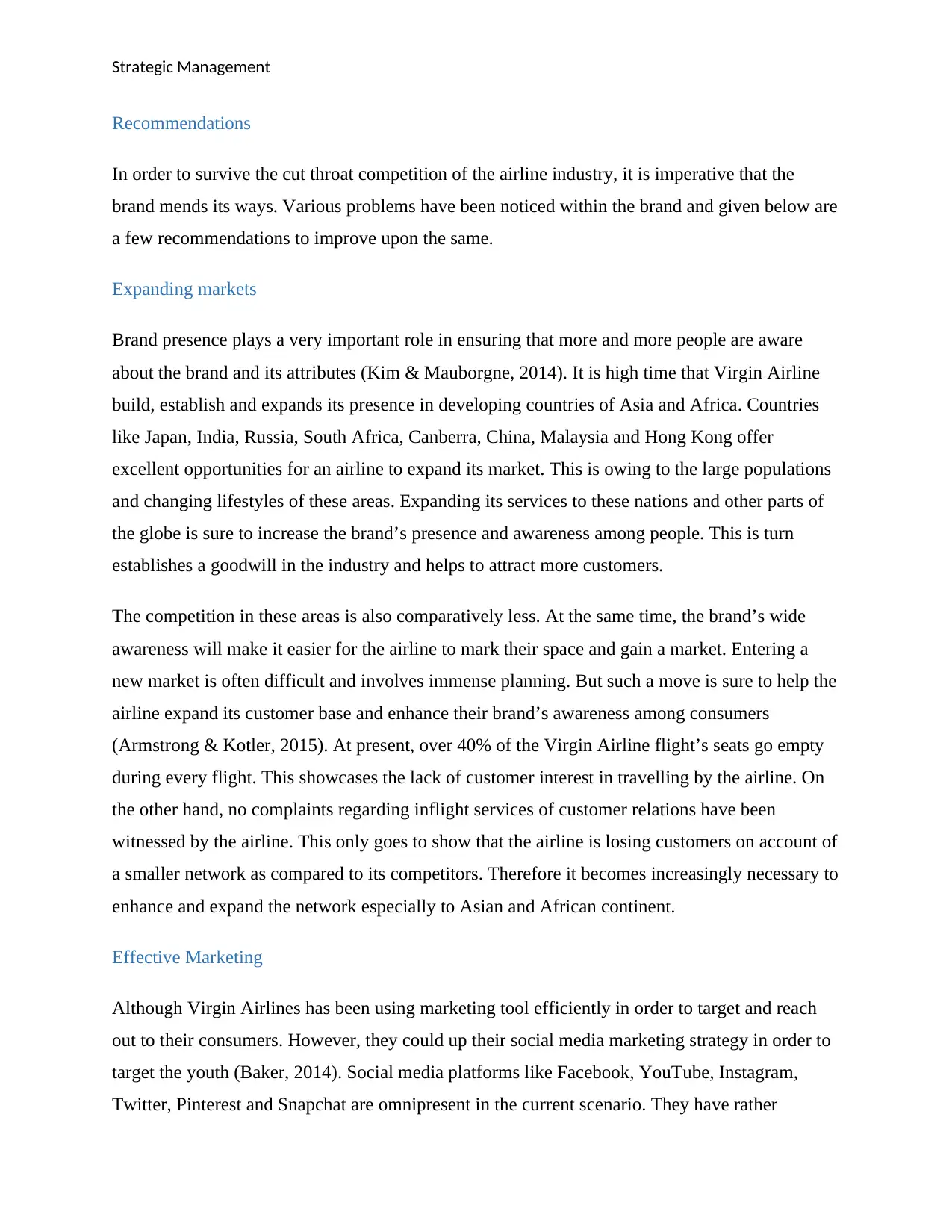
Strategic Management
Recommendations
In order to survive the cut throat competition of the airline industry, it is imperative that the
brand mends its ways. Various problems have been noticed within the brand and given below are
a few recommendations to improve upon the same.
Expanding markets
Brand presence plays a very important role in ensuring that more and more people are aware
about the brand and its attributes (Kim & Mauborgne, 2014). It is high time that Virgin Airline
build, establish and expands its presence in developing countries of Asia and Africa. Countries
like Japan, India, Russia, South Africa, Canberra, China, Malaysia and Hong Kong offer
excellent opportunities for an airline to expand its market. This is owing to the large populations
and changing lifestyles of these areas. Expanding its services to these nations and other parts of
the globe is sure to increase the brand’s presence and awareness among people. This is turn
establishes a goodwill in the industry and helps to attract more customers.
The competition in these areas is also comparatively less. At the same time, the brand’s wide
awareness will make it easier for the airline to mark their space and gain a market. Entering a
new market is often difficult and involves immense planning. But such a move is sure to help the
airline expand its customer base and enhance their brand’s awareness among consumers
(Armstrong & Kotler, 2015). At present, over 40% of the Virgin Airline flight’s seats go empty
during every flight. This showcases the lack of customer interest in travelling by the airline. On
the other hand, no complaints regarding inflight services of customer relations have been
witnessed by the airline. This only goes to show that the airline is losing customers on account of
a smaller network as compared to its competitors. Therefore it becomes increasingly necessary to
enhance and expand the network especially to Asian and African continent.
Effective Marketing
Although Virgin Airlines has been using marketing tool efficiently in order to target and reach
out to their consumers. However, they could up their social media marketing strategy in order to
target the youth (Baker, 2014). Social media platforms like Facebook, YouTube, Instagram,
Twitter, Pinterest and Snapchat are omnipresent in the current scenario. They have rather
Recommendations
In order to survive the cut throat competition of the airline industry, it is imperative that the
brand mends its ways. Various problems have been noticed within the brand and given below are
a few recommendations to improve upon the same.
Expanding markets
Brand presence plays a very important role in ensuring that more and more people are aware
about the brand and its attributes (Kim & Mauborgne, 2014). It is high time that Virgin Airline
build, establish and expands its presence in developing countries of Asia and Africa. Countries
like Japan, India, Russia, South Africa, Canberra, China, Malaysia and Hong Kong offer
excellent opportunities for an airline to expand its market. This is owing to the large populations
and changing lifestyles of these areas. Expanding its services to these nations and other parts of
the globe is sure to increase the brand’s presence and awareness among people. This is turn
establishes a goodwill in the industry and helps to attract more customers.
The competition in these areas is also comparatively less. At the same time, the brand’s wide
awareness will make it easier for the airline to mark their space and gain a market. Entering a
new market is often difficult and involves immense planning. But such a move is sure to help the
airline expand its customer base and enhance their brand’s awareness among consumers
(Armstrong & Kotler, 2015). At present, over 40% of the Virgin Airline flight’s seats go empty
during every flight. This showcases the lack of customer interest in travelling by the airline. On
the other hand, no complaints regarding inflight services of customer relations have been
witnessed by the airline. This only goes to show that the airline is losing customers on account of
a smaller network as compared to its competitors. Therefore it becomes increasingly necessary to
enhance and expand the network especially to Asian and African continent.
Effective Marketing
Although Virgin Airlines has been using marketing tool efficiently in order to target and reach
out to their consumers. However, they could up their social media marketing strategy in order to
target the youth (Baker, 2014). Social media platforms like Facebook, YouTube, Instagram,
Twitter, Pinterest and Snapchat are omnipresent in the current scenario. They have rather
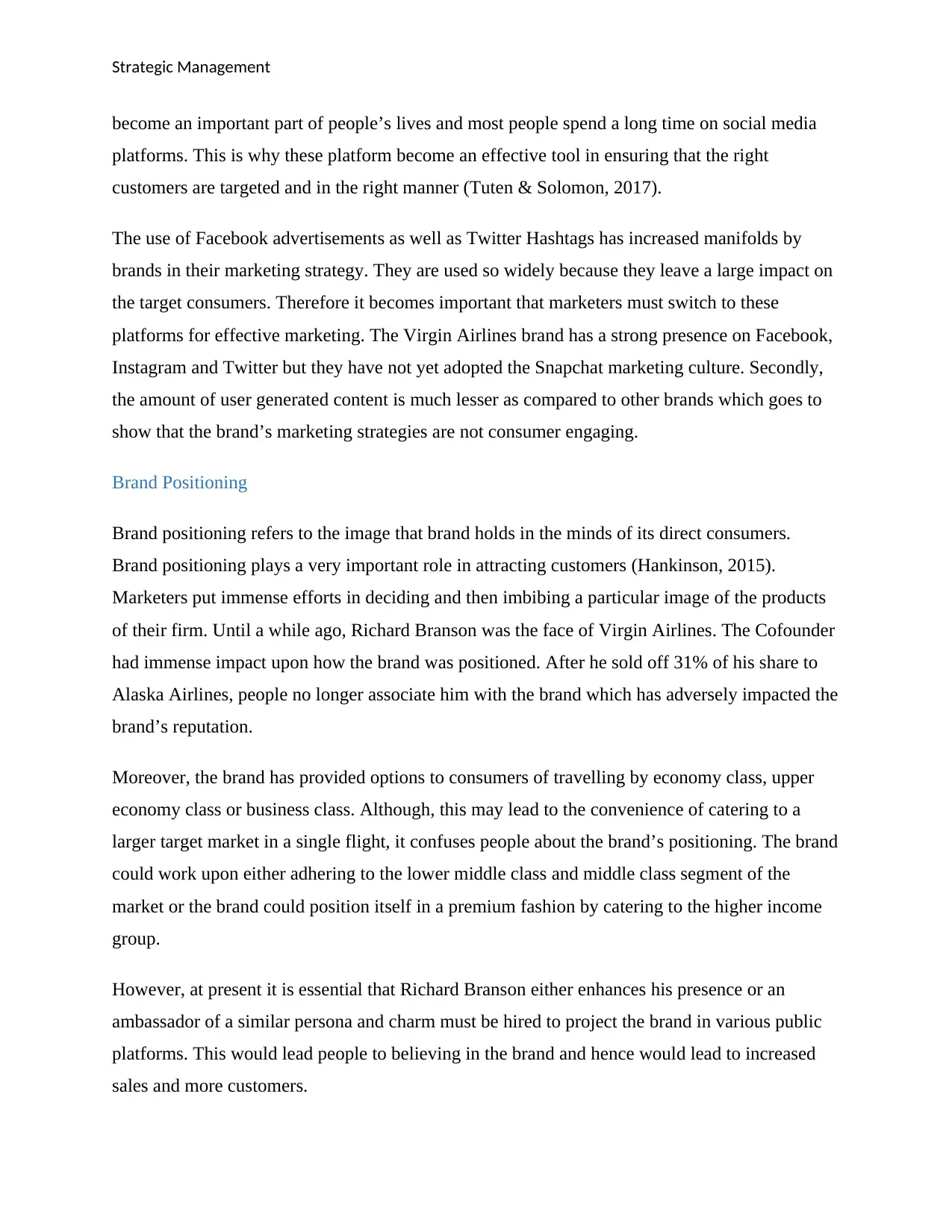
Strategic Management
become an important part of people’s lives and most people spend a long time on social media
platforms. This is why these platform become an effective tool in ensuring that the right
customers are targeted and in the right manner (Tuten & Solomon, 2017).
The use of Facebook advertisements as well as Twitter Hashtags has increased manifolds by
brands in their marketing strategy. They are used so widely because they leave a large impact on
the target consumers. Therefore it becomes important that marketers must switch to these
platforms for effective marketing. The Virgin Airlines brand has a strong presence on Facebook,
Instagram and Twitter but they have not yet adopted the Snapchat marketing culture. Secondly,
the amount of user generated content is much lesser as compared to other brands which goes to
show that the brand’s marketing strategies are not consumer engaging.
Brand Positioning
Brand positioning refers to the image that brand holds in the minds of its direct consumers.
Brand positioning plays a very important role in attracting customers (Hankinson, 2015).
Marketers put immense efforts in deciding and then imbibing a particular image of the products
of their firm. Until a while ago, Richard Branson was the face of Virgin Airlines. The Cofounder
had immense impact upon how the brand was positioned. After he sold off 31% of his share to
Alaska Airlines, people no longer associate him with the brand which has adversely impacted the
brand’s reputation.
Moreover, the brand has provided options to consumers of travelling by economy class, upper
economy class or business class. Although, this may lead to the convenience of catering to a
larger target market in a single flight, it confuses people about the brand’s positioning. The brand
could work upon either adhering to the lower middle class and middle class segment of the
market or the brand could position itself in a premium fashion by catering to the higher income
group.
However, at present it is essential that Richard Branson either enhances his presence or an
ambassador of a similar persona and charm must be hired to project the brand in various public
platforms. This would lead people to believing in the brand and hence would lead to increased
sales and more customers.
become an important part of people’s lives and most people spend a long time on social media
platforms. This is why these platform become an effective tool in ensuring that the right
customers are targeted and in the right manner (Tuten & Solomon, 2017).
The use of Facebook advertisements as well as Twitter Hashtags has increased manifolds by
brands in their marketing strategy. They are used so widely because they leave a large impact on
the target consumers. Therefore it becomes important that marketers must switch to these
platforms for effective marketing. The Virgin Airlines brand has a strong presence on Facebook,
Instagram and Twitter but they have not yet adopted the Snapchat marketing culture. Secondly,
the amount of user generated content is much lesser as compared to other brands which goes to
show that the brand’s marketing strategies are not consumer engaging.
Brand Positioning
Brand positioning refers to the image that brand holds in the minds of its direct consumers.
Brand positioning plays a very important role in attracting customers (Hankinson, 2015).
Marketers put immense efforts in deciding and then imbibing a particular image of the products
of their firm. Until a while ago, Richard Branson was the face of Virgin Airlines. The Cofounder
had immense impact upon how the brand was positioned. After he sold off 31% of his share to
Alaska Airlines, people no longer associate him with the brand which has adversely impacted the
brand’s reputation.
Moreover, the brand has provided options to consumers of travelling by economy class, upper
economy class or business class. Although, this may lead to the convenience of catering to a
larger target market in a single flight, it confuses people about the brand’s positioning. The brand
could work upon either adhering to the lower middle class and middle class segment of the
market or the brand could position itself in a premium fashion by catering to the higher income
group.
However, at present it is essential that Richard Branson either enhances his presence or an
ambassador of a similar persona and charm must be hired to project the brand in various public
platforms. This would lead people to believing in the brand and hence would lead to increased
sales and more customers.
⊘ This is a preview!⊘
Do you want full access?
Subscribe today to unlock all pages.

Trusted by 1+ million students worldwide
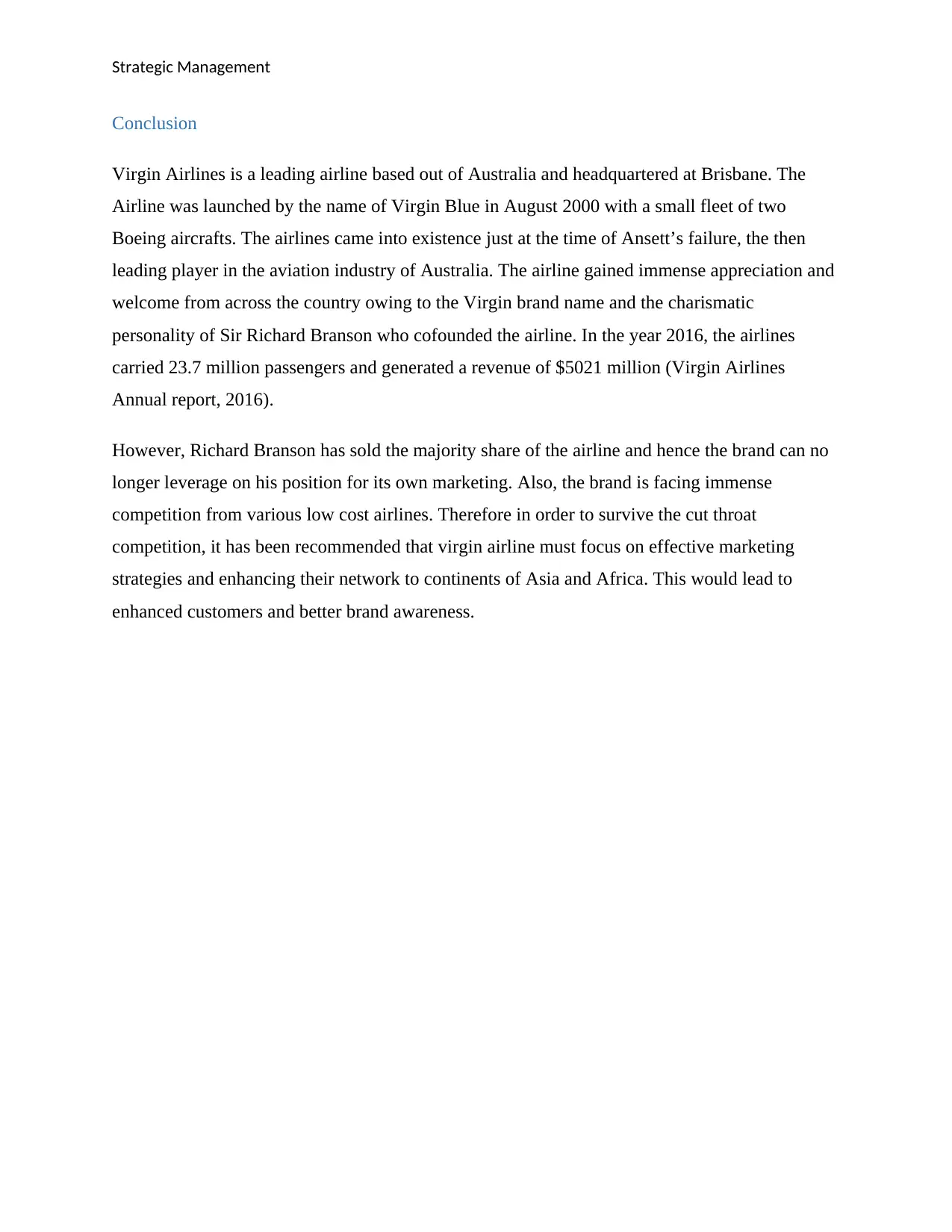
Strategic Management
Conclusion
Virgin Airlines is a leading airline based out of Australia and headquartered at Brisbane. The
Airline was launched by the name of Virgin Blue in August 2000 with a small fleet of two
Boeing aircrafts. The airlines came into existence just at the time of Ansett’s failure, the then
leading player in the aviation industry of Australia. The airline gained immense appreciation and
welcome from across the country owing to the Virgin brand name and the charismatic
personality of Sir Richard Branson who cofounded the airline. In the year 2016, the airlines
carried 23.7 million passengers and generated a revenue of $5021 million (Virgin Airlines
Annual report, 2016).
However, Richard Branson has sold the majority share of the airline and hence the brand can no
longer leverage on his position for its own marketing. Also, the brand is facing immense
competition from various low cost airlines. Therefore in order to survive the cut throat
competition, it has been recommended that virgin airline must focus on effective marketing
strategies and enhancing their network to continents of Asia and Africa. This would lead to
enhanced customers and better brand awareness.
Conclusion
Virgin Airlines is a leading airline based out of Australia and headquartered at Brisbane. The
Airline was launched by the name of Virgin Blue in August 2000 with a small fleet of two
Boeing aircrafts. The airlines came into existence just at the time of Ansett’s failure, the then
leading player in the aviation industry of Australia. The airline gained immense appreciation and
welcome from across the country owing to the Virgin brand name and the charismatic
personality of Sir Richard Branson who cofounded the airline. In the year 2016, the airlines
carried 23.7 million passengers and generated a revenue of $5021 million (Virgin Airlines
Annual report, 2016).
However, Richard Branson has sold the majority share of the airline and hence the brand can no
longer leverage on his position for its own marketing. Also, the brand is facing immense
competition from various low cost airlines. Therefore in order to survive the cut throat
competition, it has been recommended that virgin airline must focus on effective marketing
strategies and enhancing their network to continents of Asia and Africa. This would lead to
enhanced customers and better brand awareness.
Paraphrase This Document
Need a fresh take? Get an instant paraphrase of this document with our AI Paraphraser
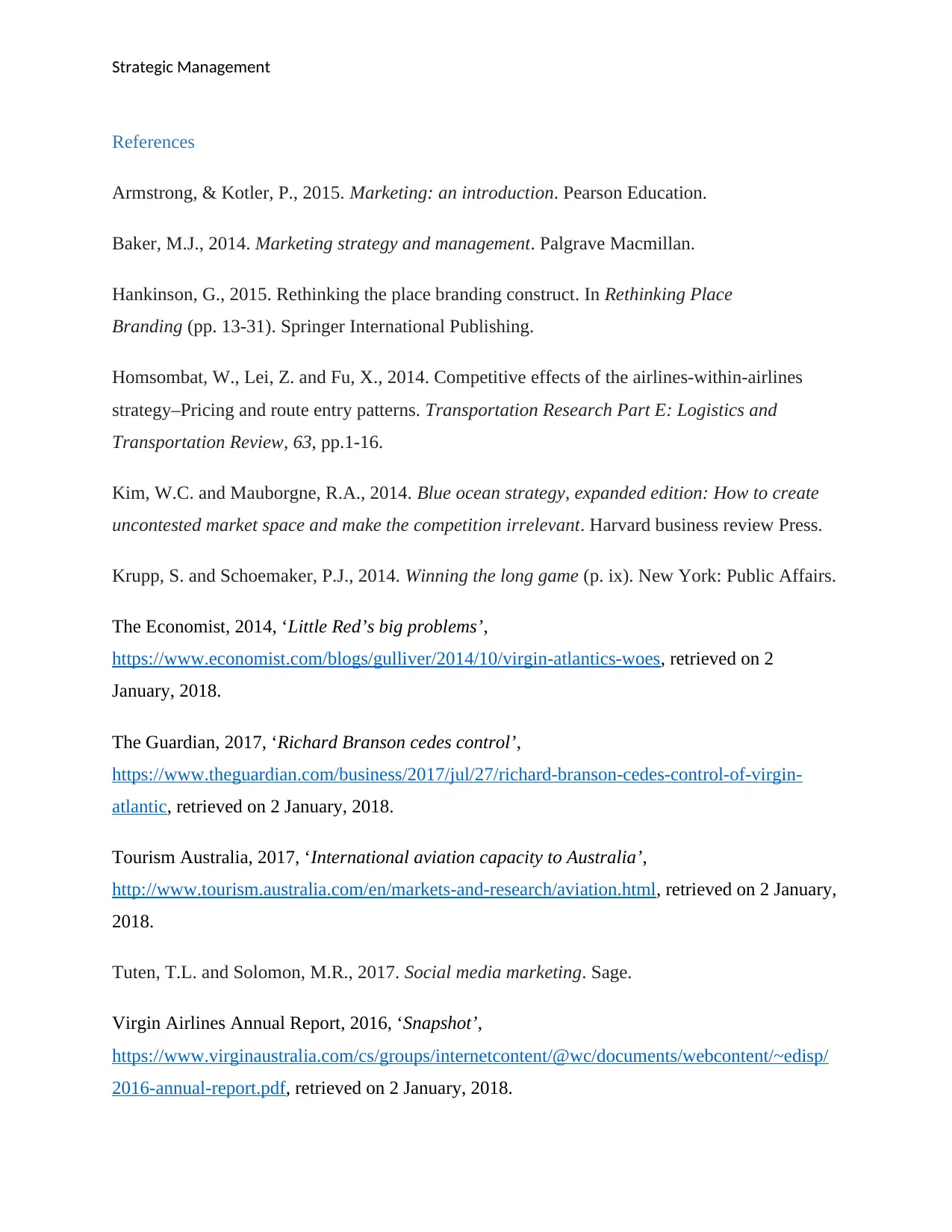
Strategic Management
References
Armstrong, & Kotler, P., 2015. Marketing: an introduction. Pearson Education.
Baker, M.J., 2014. Marketing strategy and management. Palgrave Macmillan.
Hankinson, G., 2015. Rethinking the place branding construct. In Rethinking Place
Branding (pp. 13-31). Springer International Publishing.
Homsombat, W., Lei, Z. and Fu, X., 2014. Competitive effects of the airlines-within-airlines
strategy–Pricing and route entry patterns. Transportation Research Part E: Logistics and
Transportation Review, 63, pp.1-16.
Kim, W.C. and Mauborgne, R.A., 2014. Blue ocean strategy, expanded edition: How to create
uncontested market space and make the competition irrelevant. Harvard business review Press.
Krupp, S. and Schoemaker, P.J., 2014. Winning the long game (p. ix). New York: Public Affairs.
The Economist, 2014, ‘Little Red’s big problems’,
https://www.economist.com/blogs/gulliver/2014/10/virgin-atlantics-woes, retrieved on 2
January, 2018.
The Guardian, 2017, ‘Richard Branson cedes control’,
https://www.theguardian.com/business/2017/jul/27/richard-branson-cedes-control-of-virgin-
atlantic, retrieved on 2 January, 2018.
Tourism Australia, 2017, ‘International aviation capacity to Australia’,
http://www.tourism.australia.com/en/markets-and-research/aviation.html, retrieved on 2 January,
2018.
Tuten, T.L. and Solomon, M.R., 2017. Social media marketing. Sage.
Virgin Airlines Annual Report, 2016, ‘Snapshot’,
https://www.virginaustralia.com/cs/groups/internetcontent/@wc/documents/webcontent/~edisp/
2016-annual-report.pdf, retrieved on 2 January, 2018.
References
Armstrong, & Kotler, P., 2015. Marketing: an introduction. Pearson Education.
Baker, M.J., 2014. Marketing strategy and management. Palgrave Macmillan.
Hankinson, G., 2015. Rethinking the place branding construct. In Rethinking Place
Branding (pp. 13-31). Springer International Publishing.
Homsombat, W., Lei, Z. and Fu, X., 2014. Competitive effects of the airlines-within-airlines
strategy–Pricing and route entry patterns. Transportation Research Part E: Logistics and
Transportation Review, 63, pp.1-16.
Kim, W.C. and Mauborgne, R.A., 2014. Blue ocean strategy, expanded edition: How to create
uncontested market space and make the competition irrelevant. Harvard business review Press.
Krupp, S. and Schoemaker, P.J., 2014. Winning the long game (p. ix). New York: Public Affairs.
The Economist, 2014, ‘Little Red’s big problems’,
https://www.economist.com/blogs/gulliver/2014/10/virgin-atlantics-woes, retrieved on 2
January, 2018.
The Guardian, 2017, ‘Richard Branson cedes control’,
https://www.theguardian.com/business/2017/jul/27/richard-branson-cedes-control-of-virgin-
atlantic, retrieved on 2 January, 2018.
Tourism Australia, 2017, ‘International aviation capacity to Australia’,
http://www.tourism.australia.com/en/markets-and-research/aviation.html, retrieved on 2 January,
2018.
Tuten, T.L. and Solomon, M.R., 2017. Social media marketing. Sage.
Virgin Airlines Annual Report, 2016, ‘Snapshot’,
https://www.virginaustralia.com/cs/groups/internetcontent/@wc/documents/webcontent/~edisp/
2016-annual-report.pdf, retrieved on 2 January, 2018.
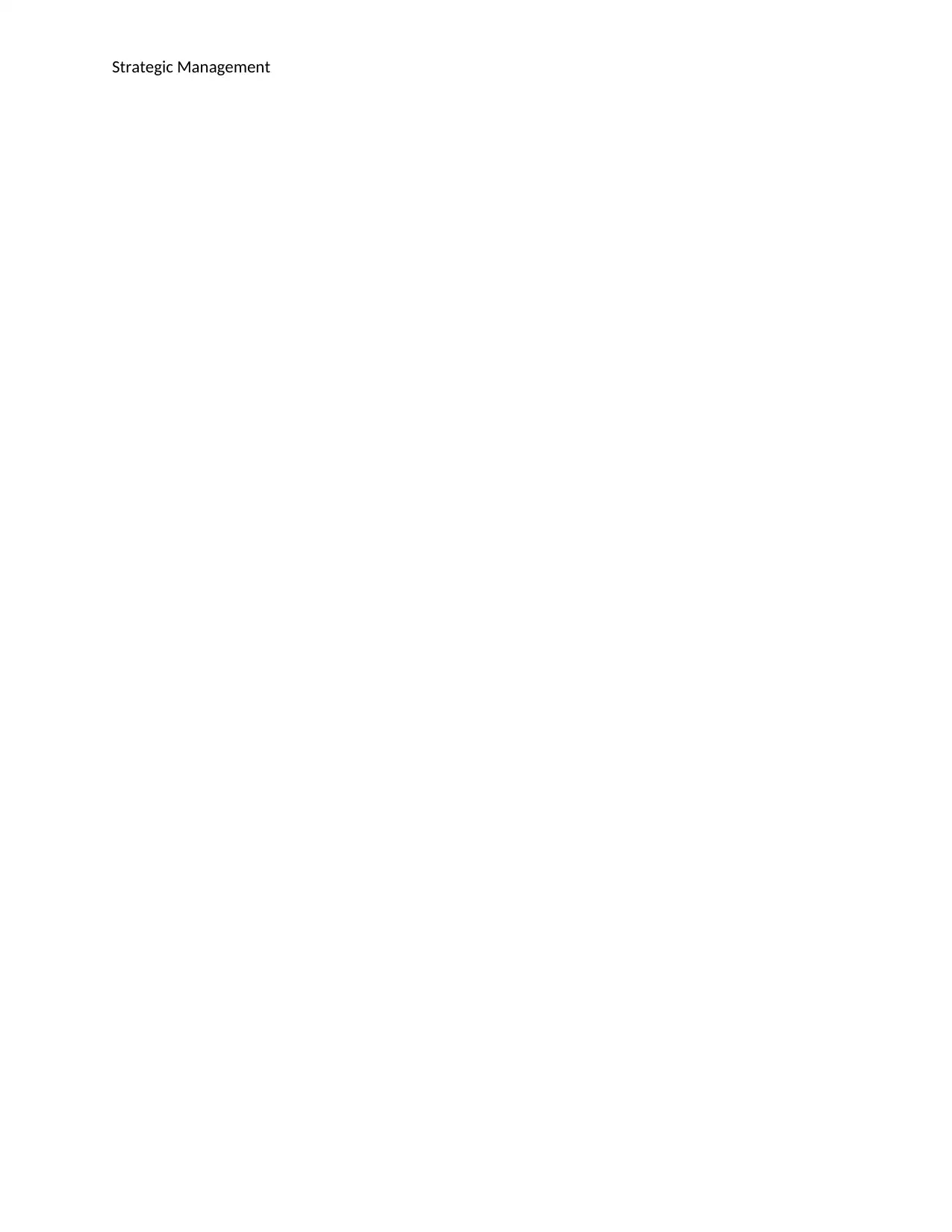
Strategic Management
⊘ This is a preview!⊘
Do you want full access?
Subscribe today to unlock all pages.

Trusted by 1+ million students worldwide
1 out of 9
Related Documents
Your All-in-One AI-Powered Toolkit for Academic Success.
+13062052269
info@desklib.com
Available 24*7 on WhatsApp / Email
![[object Object]](/_next/static/media/star-bottom.7253800d.svg)
Unlock your academic potential
Copyright © 2020–2025 A2Z Services. All Rights Reserved. Developed and managed by ZUCOL.





